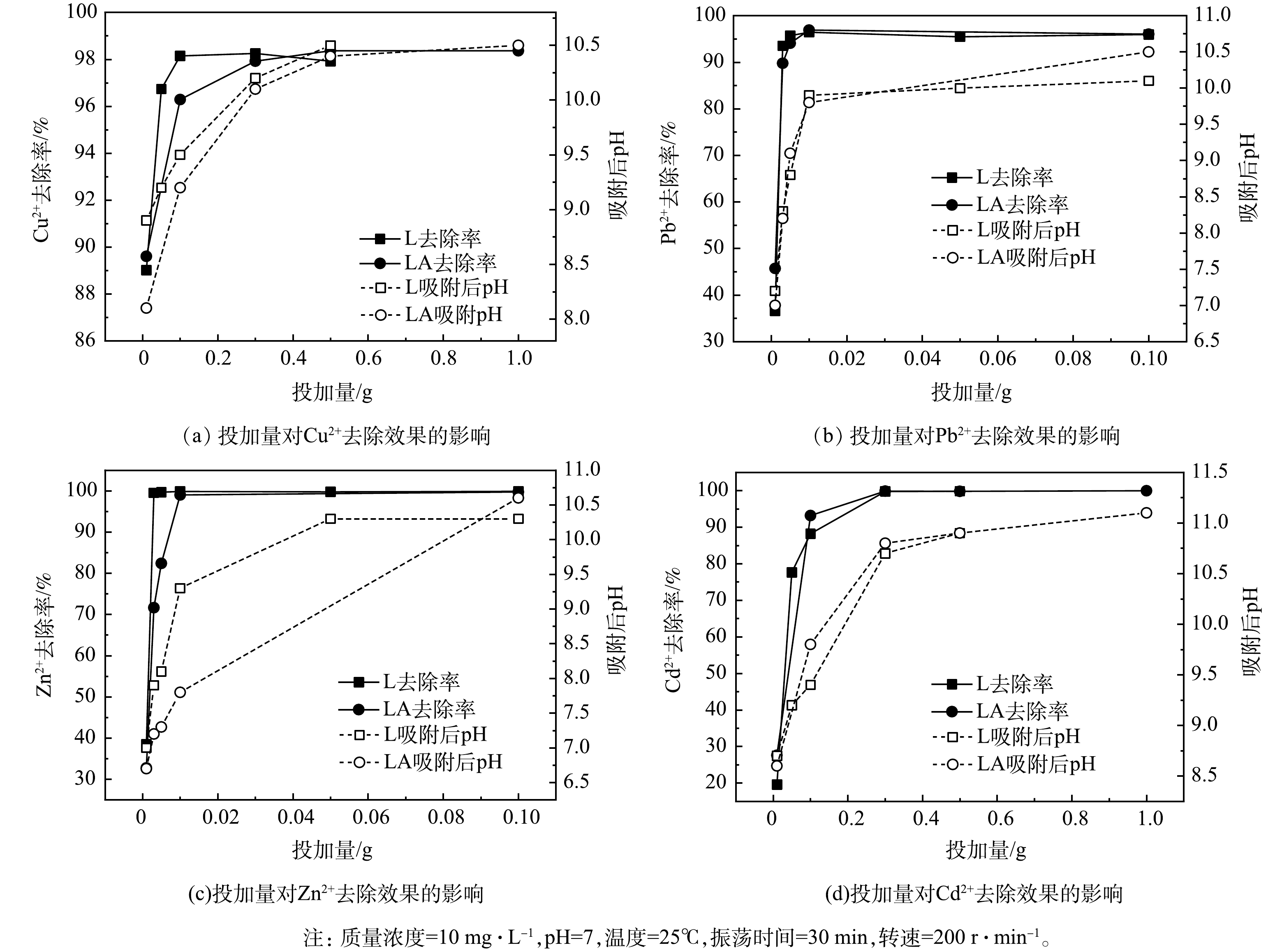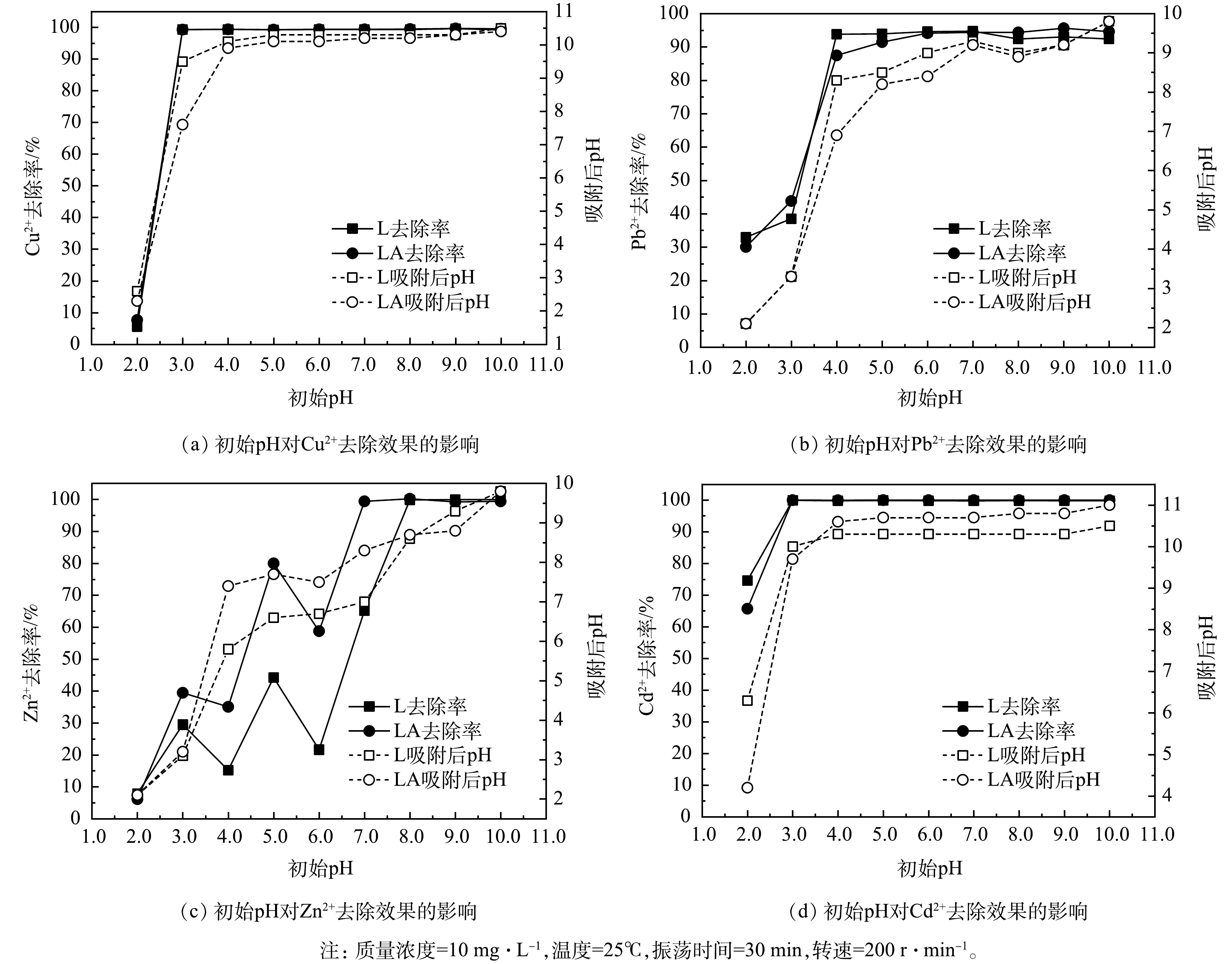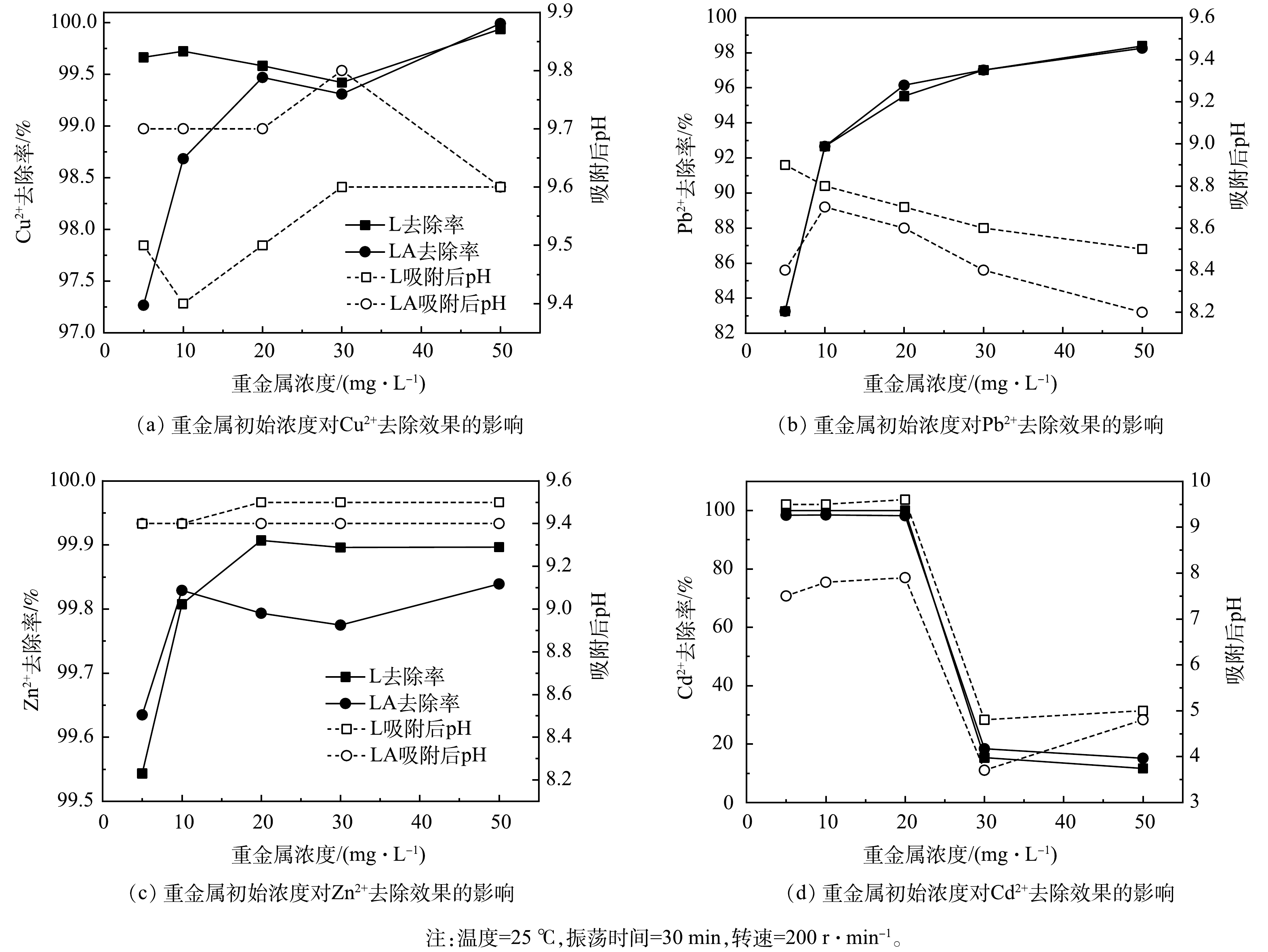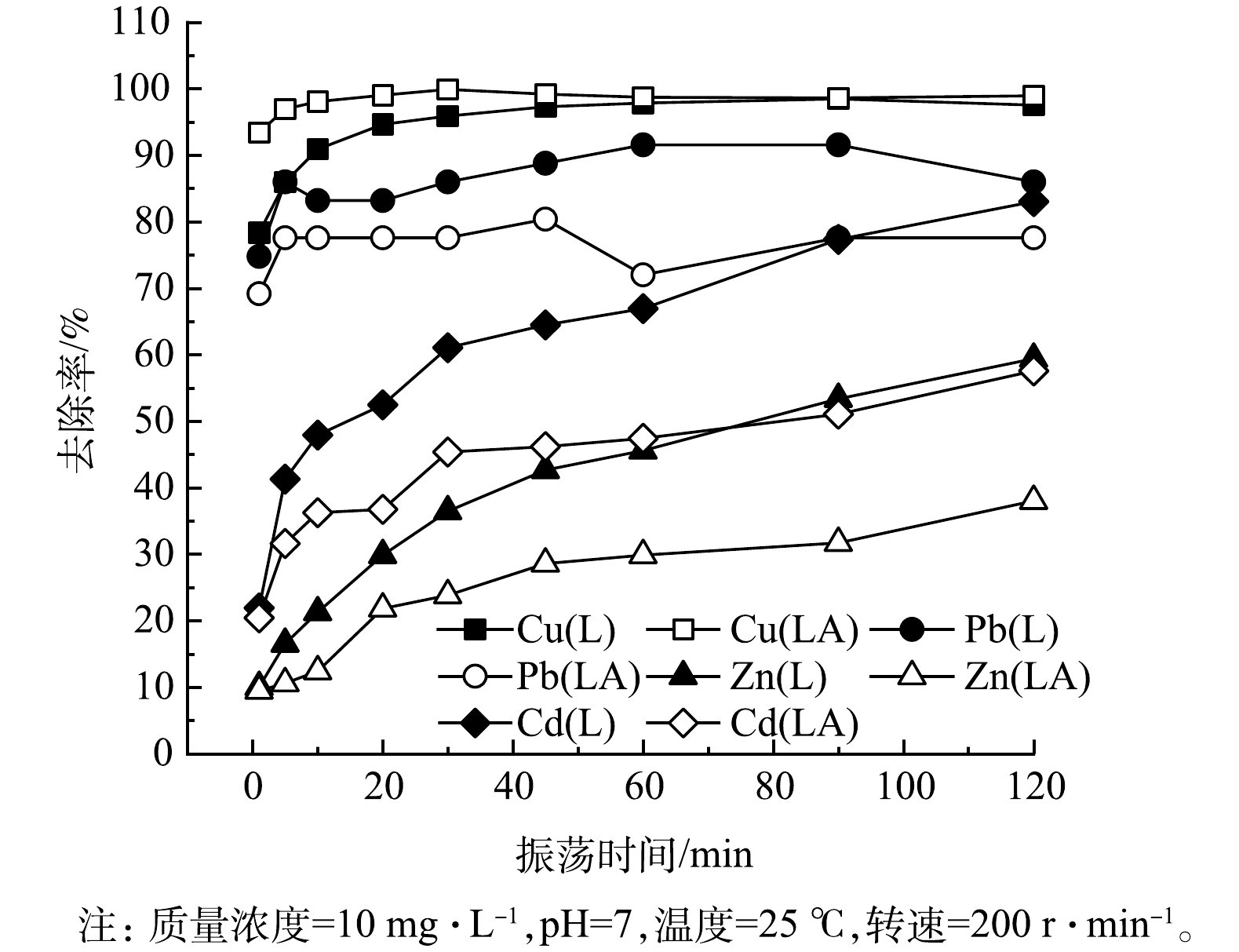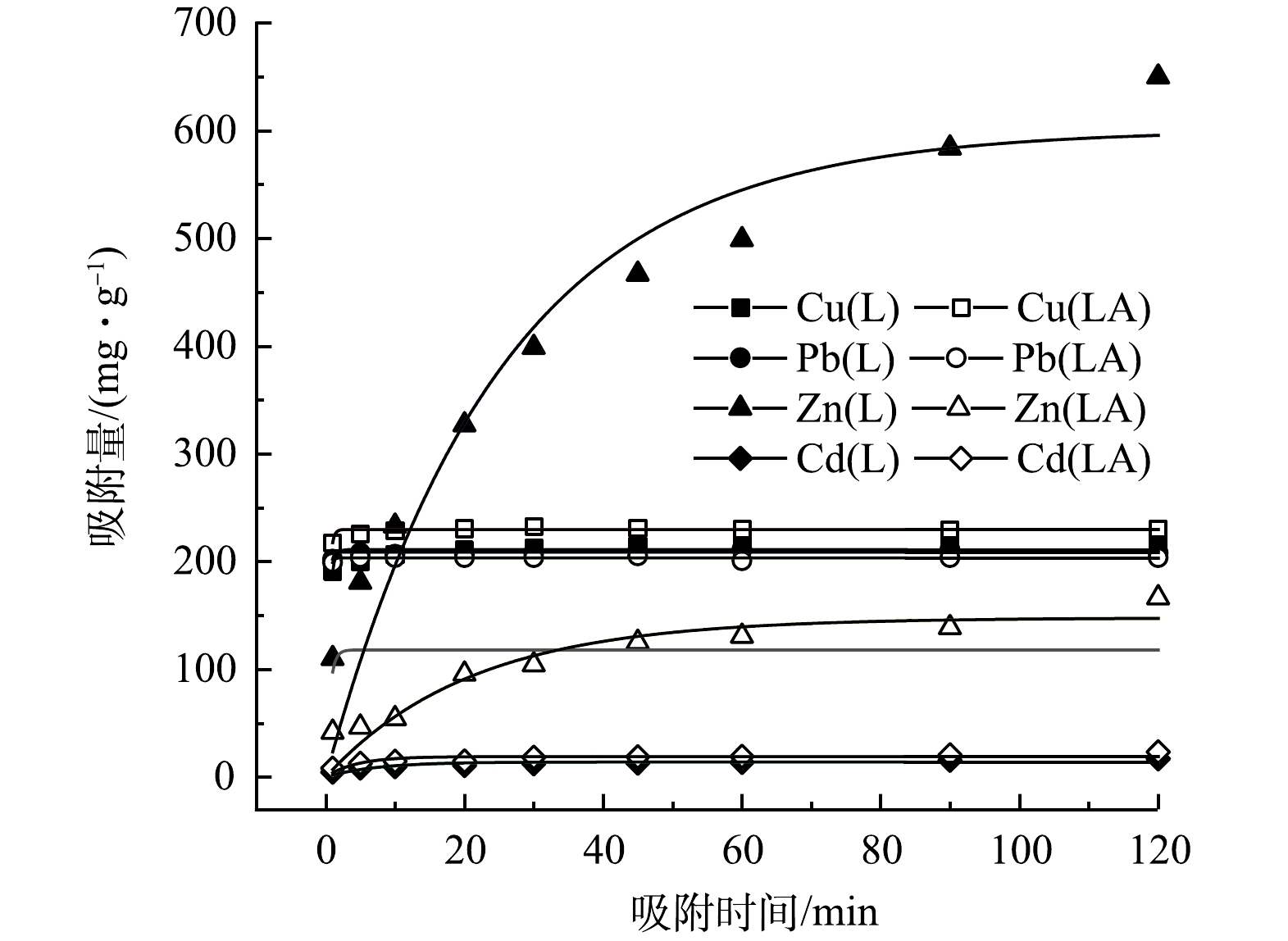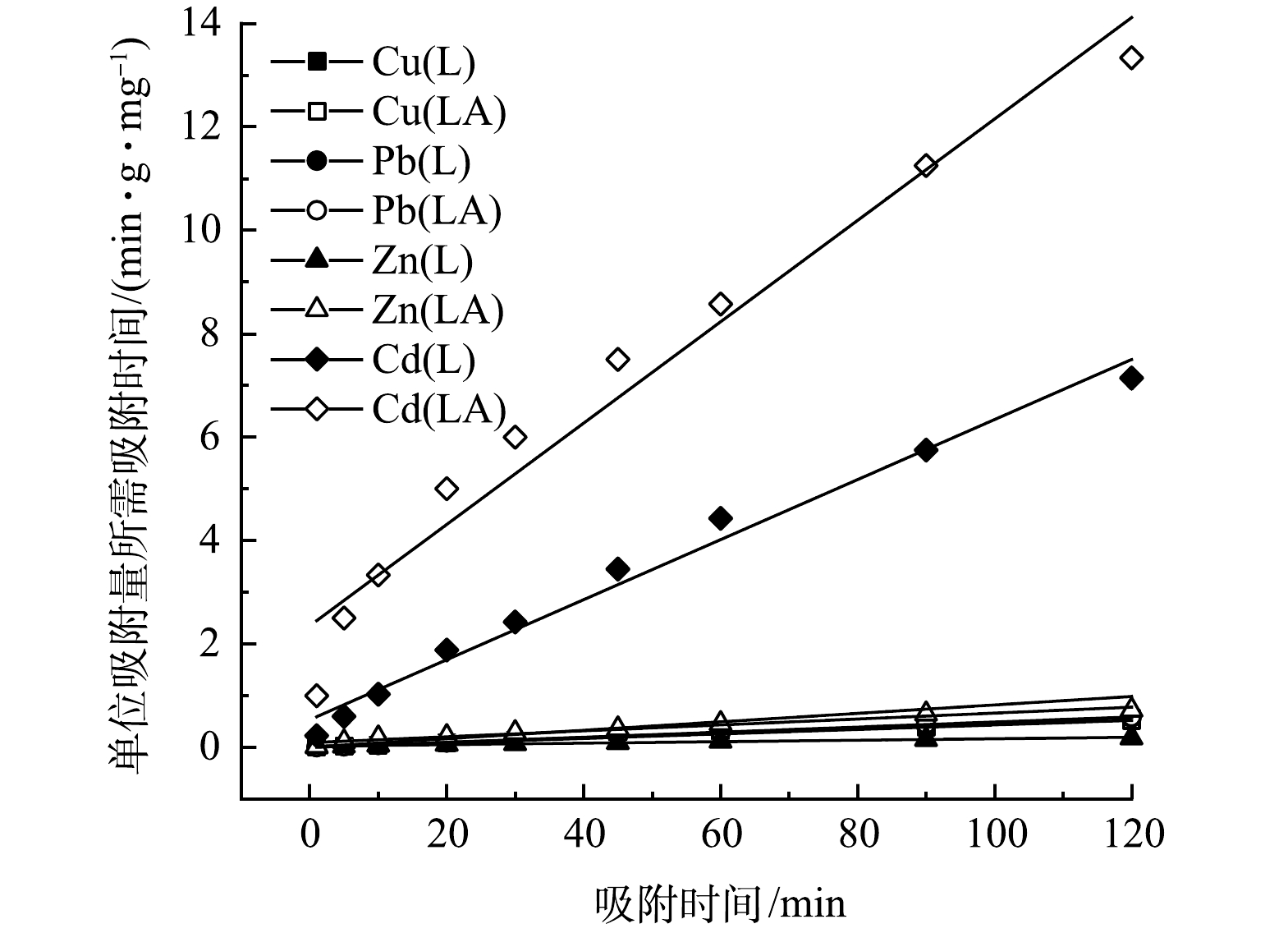-
近年来,我国矿冶、机械制造、化工、电子、仪表等行业高速发展,相关企业的生产过程中几乎都会产生重金属废水。由于部分工矿企业的不达标排放,造成了严重的重金属污染[1]。大多数重金属都具有毒性,如果直接排放到水环境中,会通过食物链富集对水生生物和人类健康造成威胁[2]。目前,国内外关于重金属废水的处理方法主要包括生物絮凝法、吸附法、化学沉淀法、电化学法、絮凝法等[3]。其中吸附法和絮凝法作为传统且成熟的方法应用极为广泛,经济、高效且环境友好是评价吸附剂和絮凝剂的主要指标[4]。寻找具有广泛pH适应性且能够对抗实际复杂环境中不利影响的絮凝吸附药剂,是提高该方法处理重金属废水效率的关键[5]。
在重金属废水处理中,使用的材料必须易于获得、制备容易、投加操作简单、成本低,才可能被广泛推广应用[6]。许多建筑材料易于获得且价格相对较低,具有用于处理重金属废水的潜力[7]。在这类材料之中,水泥类材料生产技术成熟、产量高[8] (2020年我国水泥产量达15×109 t左右[9]),且和其他同类材料相比具有生产容易、经济高效等优点。目前,已经有用水泥类材料处理废水中重金属的报道。陈怡等[10]采用普通硅酸盐水泥和石灰的混合物对酸性重金属废水进行处理,通过石灰提供Ca2+和碱度来提高重金属离子的去除率,发现在弱酸条件下水泥能较好去除废水中Cu2+、Pb2+。樊志金[11]采用水泥+石灰、水泥+石灰+絮凝剂2种方案,在未考虑重金属离子间的相互影响下对比了2种方案下金属离子的沉淀效果。李国新等[12]使用硫铝酸盐水泥-膨润土制备了一种复合材料用于重金属废水的处理,该材料对辅料配比要求严格,制备较为复杂,普遍适用性有待进一步提高。在水泥材料用于重金属废水处理的相关研究中,一般都需要加入其他辅料来改善水泥的性能,还需要根据不同来水水质采用不同的配比。而水泥材料本身具有良好的重金属去除性能,兼具了经济性和安全性,如何在不添加其他辅料的情况下放大水泥基材料自身的优势,使其能够在实际复杂环境中适应广泛的pH条件,对抗不利影响,提高处理效率,还需要进一步探究。
硫铝酸盐水泥是 20 世纪 80 年代出现的水泥品种,以硫铝酸钙矿物与铁相矿物为主要成分。其水化物液相pH较高,为12.0~12.5[13],水化活性显著高于普通硅酸盐水泥,能够提供强碱度中和金属离子废水的酸度并生成难溶性沉淀;另外,硫铝酸盐水泥水化可产生的大量铁胶与铝胶[14],而铁系和铝系絮凝剂是目前应用广泛、工艺成熟的无机金属盐絮凝剂[3],可以通过絮凝作用促进重金属离子的网捕沉淀去除。此前,课题组在对湖库中低浓度磷的去除实验中发现硫铝酸盐水泥能在pH为5.0~8.0时形成絮凝体[15],可较好地吸附磷。一般来说,絮凝体对废水中的金属阳离子具有较好的去除效果。为进一步增加材料的应用场景,基于上述研究,本研究选择硫铝酸盐水泥(L)及其改性材料(LA)为重金属离子清除剂,以Cu2+、Pb2+、Zn2+、Cd2+为研究对象,考察了清除剂投加量、废水初始pH、重金属离子初始浓度、振荡时间等因素对L和LA去除重金属的影响,优化了最佳应用条件,通过竞争吸附和分析动力学原理,研究了不同重金属离子间的相互影响,解析了硫铝酸盐水泥及其改性材料去除重金属的机理,以期为该类型材料的推广应用提供参考。
-
本研究所用硫铝酸盐水泥(L)购自峨眉山强华特种水泥有限责任公司。硫铝酸盐水泥的主要成分为 CaO(35.12%)、Al2O3(28.77%)、SiO2(15.74%)、Fe2O3(1.45%)、SO3(8.46%)、MgO(0.96%)、TiO2(0.49%)、K2O(0.71%)、Na2O(0.50%)、其他成分(7.80 %)[15]。硫铝酸盐水泥经过水化和酸化改性后制得改性材料LA。制备方法为:称取10 g L于500 mL锥形瓶中,加入适量纯水,在(25±1) ℃的条件下振荡30 min,使其充分水化;调节pH至7.0,出现絮凝体,即酸化过程;以2 000 r·min−1将溶液离心,取沉淀置于60 ℃烘箱中烘干,用研钵研磨过80目筛后,装袋备用。
本实验依据《水质 铜、锌、铅、镉的测定 原子吸收分光光度法》(GB 7475-87)[16]测定水体中重金属含量,所用火焰原子吸收分光光度计为4530F。
-
本研究通过实验室模拟来探究L和LA处理Cu2+、Pb2+、Zn2+、Cd2+ 4种重金属废水的性能,实验配制单一重金属废水,用Cu、Pb、Zn、Cd单元素标准溶液和1+499硝酸溶液配制初始质量浓度分别为5、10、20、30、50 mg·L−1的单组分模拟废水。以重金属初始浓度作为影响因素的单一变量实验时设置梯度浓度,其余实验均取重金属初始质量浓度10 mg·L−1的单组分模拟废水。
-
本研究在LA除磷研究[15]的基础上探究其对重金属的去除能力,初始条件考虑除磷的最佳条件。在LA投加量为0.10 g·L−1时,可将0.1 mg·L−1的磷酸盐完全去除,最适pH为5.0~8.0,温度对去除率无明显影响,当振荡速度为140 r·min−1及其以上时,因高强度扰动造成絮体表面膜状物破坏,去除效果有所下降 [15]。综合考虑上述研究结果和文献数据[10],选定pH=7.0、振荡速度200 r·min−1、振荡时间30 min,温度25 ℃作为本次实验的初始参数,实验步骤详述如下。
1)影响因素实验。采用控制变量法,考察材料投加量、废水初始pH、重金属初始浓度、振荡时间4种因素对L和LA去除重金属效果的影响。
取初始质量浓度均为10 mg·L−1 的4种(Cu2+、Pb2+、Zn2+、Cd2+)单组分模拟重金属废水,调节初始pH为7.0,每种分别取100 mL到10个聚乙烯瓶中,5个为1组,并分别向两组投入梯度量的L和LA。Cu2+废水和Cd2+废水中L的投加量为:0.010、0.050、0.100、0.300、0.500 g,LA的投加量为:0.010、0.100、0.300、0.500、1.000 g;Pb2+废水和Zn2+废水中L的投加量为:0.001、0.003、0.005、0.010、0.050 g,LA的投加量为:0.001、0.003、0.005、0.010、0.100 g。在(25±1) ℃下,以200 r·min−1转速振荡30 min,振荡结束后静置10 min,用针管取上清液用滤头过滤,测定反应后溶液pH和重金属离子浓度。
取初始质量浓度均为10 mg·L−1 的4种(Cu2+、Pb2+、Zn2+、Cd2+)单组分模拟重金属废水,每种重金属废水用NaOH溶液和HNO3溶液调节初始pH为2.0、3.0、4.0、5.0、6.0、7.0、8.0、9.0、10.0,各取100 mL于聚乙烯瓶中,基于投加量实验结果称取L和LA的最佳投加量投入,即Cu2+废水中L和LA的投加量均为1 g·L−1;Pb2+废水中投加量均为0.05 g·L−1;Zn2+废水中投加量分别为L 0.05 g·L−1和LA 0.1 g·L−1;Cd2+废水中投加量均为3 g·L−1。在(25±1) ℃下,以200 r·min−1转速振荡30 min,振荡结束后静置10 min,用针管取上清液用滤头过滤,测定反应后溶液pH和重金属离子浓度。
取初始质量浓度为5、10、20、30、50 mg·L−1的4种 (Cu2+、Pb2+、Zn2+、Cd2+)单组分模拟重金属废水,基于pH实验得到改性前后材料对同一离子的最适pH存在差异,为更好地对L和LA的去除效果进行比较,该实验同一种离子废水设定相同的初始pH,即Cu2+废水pH为9.0;Pb2+废水pH为7.0;Zn2+废水pH为8.0;Cd2+废水pH为3.0。每种废水各取100 mL于聚乙烯瓶中,基于投加量实验结果称取L和LA的最佳投加量投入,即Cu2+废水中L和LA的投加量为1 g·L−1;Pb2+废水中投加量均为0.05 g·L−1;Zn2+废水中投加量分别为0.05 g·L−1和0.1 g·L−1;Cd2+废水中投加量均为3 g·L−1。在(25±1) ℃下,以200 r·min−1转速振荡30 min,振荡结束后静置10 min,用针管取上清液用滤头过滤,测定反应后溶液pH和重金属离子浓度。
取初始质量浓度均为10 mg·L−1 的4种(Cu2+、Pb2+、Zn2+、Cd2+)单组分模拟重金属废水,因各重金属废水处于最佳pH状态时沉淀效果远大于絮凝效果,无法探究振荡时间对去除效果的影响,则调节初始pH均为7.0,分别取100 mL于聚乙烯瓶中。在对Cu2+进行预实验时发现,当投加量为最佳投加量时,在1 min内就已经达到吸附平衡,为更好的探究时间的影响,减少投加量,即Cu2+废水中L和LA的投加量均为0.05 g·L−1;Pb2+废水中投加量均为0.05 g·L−1;Zn2+废水中投加量分别为0.01 g·L−1和 0.025 g·L−1;Cd2+废水中投加量分别为0.5 g·L−1和 0.25 g·L−1。在(25±1) ℃下,以200 r·min−1转速分别振荡5、10、15、20、30、45、60、90、120 min,振荡结束后静置10 min,用针管取上清液用滤头过滤,测定反应后溶液pH和重金属离子浓度。
2)正交实验。为了探究不同因素对L和LA去除重金属离子影响的强弱并优化最佳应用条件,因此需进行正交实验。基于影响因素实验可得各因素的最优值,取初始质量浓度均为10 mg·L−1 的4种(Cu2+、Pb2+、Zn2+、Cd2+)单组分模拟重金属废水,将材料投加量、废水pH、振荡时间作为影响因素,采用3因素3水平正交表L9(34)安排正交实验。各因素水平参数如表1、表2所示。
3)竞争吸附实验。实际工业废水中的重金属离子并不是单一存在,而是多种重金属离子共存,因此为进一步探究L和LA在实际废水中的吸附性能,设计多组分离子溶液探究不同重金属离子间是否存在竞争吸附。取初始质量浓度均为10 mg·L−1 的4种(Cu2+、Pb2+、Zn2+、Cd2+)单组分模拟重金属废水,进行双组分、3组分及4组分组合,具体模拟废水溶液配比如表3所示。
取上述多组分废水各100 mL,调节初始pH为7.0,装入聚乙烯瓶中,分为2组,分别投入0.01 g L、0.01 g LA,在(25±1) ℃下,以200 r·min−1振荡30 min,反应后取出静置10 min,用针管取上清液用滤头过滤,测定反应后溶液pH和重金属离子浓度。
4)吸附动力学实验。实验方法同振荡时间实验方法。使用伪一级吸附动力学和伪二级吸附动力学模型[17-18]对实验所得数据进行拟合,见式(1)和式(2)。
式中:Qe和Qt分别为吸附平衡时和t时刻的吸附量,mg·g−1; t为吸附时间,min;k1、k2分别为伪一级动力学和伪二级动力学吸附动力学常数,g·(mg·min)−1。
-
实验所得数据,由origin 2018处理分析并绘制图表。对正交实验所得数据直接采用SPSS 22.0进行极差分析和方差分析,对各影响因素的显著性进行比较从而得出L和LA去除重金属的最优条件组合。
-
1) L和LA投加量对去除效果的影响。如图1所示,随着L和LA的投加量提升,4种重金属溶液pH及其去除率呈相同的变化趋势。当L和LA的投加量高于某一值后,金属离子去除率趋于稳定,考虑实际运用中的经济效益,取快速增长阶段与平稳阶段的临界值为最佳投加量。分析得出,L去除Cu2+、Pb2+、Zn2+、Cd2+的最佳投加量分别为1、0.05、0.05、0.05 g·L−1;LA对应的最佳投加量分别为1、0.05、0.1、3 g·L−1,去除率均大于94%。在相同投加量的情况下(未达到动态平衡时),L和LA对Pb2+和Zn2+的去除率均显优于Cu2+和Cd2+。这可能是由于Pb2+活性强,相比其他离子能够更加迅速的完成吸附、沉淀、结晶[10],在投加量少的时候,L对金属离子的去除率大于LA,随着投加量的增加,L与LA对金属离子的去除率逐渐趋近,但总体而言LA略高于L。L未经过酸化处理,加入溶液后前期pH大于LA,更多重金属离子生成沉淀而被去除。随着投加量增加,L和LA吸附金属离子后溶液pH相差不大,而LA由于其疏松多孔、胶结更加紧密的性质[15]容易捕捉到更多的金属离子。
2)废水初始pH对去除效果的影响。如图2所示,L和LA在吸附4种重金属后,金属离子的去除率与溶液pH的变化趋势相似,且在相同pH条件下L和LA对金属离子的去除率差异较小,仅在pH=3.0~7.0时,LA对Zn2+的去除率明显高于L。这说明LA适应的pH范围更广泛,在L不能有效去除金属离子的条件下也能够发挥较好的作用。L去除Cu2+、Pb2+、Zn2+、Cd2+的最佳pH分别为9.0、7.0、10.0、3.0;LA去除上述离子的最佳pH分别为9.0、9.0、8.0、3.0,去除率均大于94%。结果表明,L和LA大都适用于中性和碱性条件,仅有去除Cd2+时更适合偏酸性条件。由此推测,在酸性条件下,更多H+与金属离子之间存在竞争吸附,从而影响金属离子的去除效果。而去除Cd2+的最佳pH偏低的原因可能是因为Cd2+更多是以其他方式被去除,不会与H+竞争活性位点。值得注意的是,溶液pH过高会导致生成的两性氢氧化物沉淀反溶,从而影响去除率。
3)初始离子浓度对去除效果的影响。如图3所示,在不同初始浓度的Cu2+废水中,去除率均大于97%,随着离子浓度逐渐升高,L的去除率从高于LA到逐渐相等,甚至在Cu2+质量浓度为50 mg·L−1时,LA去除率已略高于L。因此,除沉淀作用外,LA可能具有更良好的吸附絮凝性能。对Pb2+而言,去除率随着溶液中Pb2+浓度的增加而增加,L同LA去除率基本一致。吸附后溶液pH下降,是由于溶液中OH−与Pb2+结合形成沉淀,溶液中OH−浓度降低导致的。对Zn2+而言,吸附后溶液pH整体稳定,虽略有波动,但去除效果优异,去除率均大于99.5%。当重金属质量浓度大于10 mg·L−1时,L去除效果优于LA。相对而言,L和LA对重金属质量浓度在10 mg·L−1以上的去除效果更好。Zn2+在溶液初始pH为8.0时已完全沉淀。对Cd2+而言,在5~20 mg·L−1去除率良好,但质量浓度大于30 mg·L−1时,金属离子去除率与溶液pH均大幅度下降。所以,应同时考虑高浓度条件下L和LA吸附达到饱和以及Cd2+形成沉淀的双重影响。随着重金属浓度的增加,吸附后溶液pH下降,在高浓度时,由于吸附位点饱和,L和LA去除金属离子主要是通过给溶液提供OH−,充当沉淀剂的作用。此时,去除机理以沉淀为主,吸附为辅。当溶液质量浓度为5~10 mg·L−1时,4种金属离子去除效果明显,除Pb2+去除率略低外,其他离子去除率均大于97%。
4)振荡时间对去除效果的影响。如图4所示,L和LA对金属离子的吸附速率很快,30 min内表观吸附速率可降到零。L和LA的反应速率变化趋势相似,几乎同时达到动态平衡。Zn2+和Cd2+的去除过程比较缓慢,但随着时间增加,去除率也有明显提升;Cu2+和Pb2+的去除过程迅速,基本在30 min内达到吸附平衡。Pb2+在后期去除率下降的原因可能是反应时间过久,L和LA中的Ca(OH)2持续释放OH−进入溶液,出现沉淀溶解的现象。
-
选取材料投加量、废水初始pH、振荡时间作为影响因素设计正交实验探究对单一重金属处理的最佳应用条件,所得实验结果如表4所示。
由表5可见,在对Cu2+的去除过程中,L和LA投加量、废水初始pH、振荡时间这3个因素中投加量的影响最大,而在Pb2+、Zn2+、Cd2+的去除中初始pH的影响最大。结果表明,3个因素对L和LA去除Cu2+、Pb2+、Cd2+的的影响均不显著(P>0.05),推测其可能不是影响去除率的主要因素。因此,在实际应用中考虑经济时间成本可使用次优组合。对Zn2+的去除进行方差分析时发现,3种因素是影响LA去除Zn2+的主要因素(P<0.05),但不是影响L去除Zn2+的主要因素(P>0.05)。后续可以尝试探究其他影响因素(如温度)对去除率的影响。
-
1)竞争吸附。不同重金属离子之间的性质存在差异,材料本身对不同离子的去除机理也有所不同,多种重金属离子共存时可能会发生竞争,往往会出现某一种离子被材料优先吸附,而影响其他离子去除率的情况。多组分重金属废水吸附后金属离子的去除率如下图5、图6所示。本实验中单组分与多组分为不同批次测定,火焰原子吸收光谱仪不同批次之间存在一定偶然误差,应对数据进行综合分析。
向多组分重金属废水中投加L后竞争吸附结果如图5所示。可以发现Cu2+的去除率几乎不受到其他离子影响,Pb2+略微受到Zn2+、Cd2+的抑制作用,Zn2+与Cd2+之间相互竞争激烈,抑制显著。在各离子分别组合的双组分废水中,Cu2+的竞争性是最强的,所受到其他离子的影响可忽略不计;其次是Zn2+,但Zn2+与Cd2+共存时去除率明显降低,在Cd2+影响Zn2+吸附的同时,Zn2+也影响Cd2+的吸附;然后是Pb2+,Zn2+对Pb2+略微有抑制;最后是Cd2+,Pb2+、Zn2+对其都有显著的抑制作用。值得一提的是,当Cu2+与Cd2+共存时,Cu2+对Cd2+的吸附有明显的促进作用,这一点可以从后面3组分与4组分的数据得到验证。在3组分及4组分的竞争吸附中,Cu2+受到Pb2+、Zn2+的抑制,去除率的极差为0.4%,影响微弱。Pb2+受到Cd2+的抑制强于Zn2+对其的抑制,此3种离子在溶液中共存时,3者相互抑制,其中Zn2+受抑制程度最显著。Cd2+受到Zn2+的抑制大于Pb2+对其的抑制。但并非如同其他研究[19-20]所表明,离子种类越多,竞争作用越强。通过与单组分的去除率进行对比发现,当Cu2+和Cd2+共存时,Cd2+的去除率反而大于单独Cd2+的去除率。对比Pb2++Zn2++Cd2+和Cu2++Pb2++Zn2++Cd2+可发现,当加入Cu2+后,其他3种重金属离子的去除率均有所提升。
向多组分重金属废水中投加LA后竞争吸附结果如图6所示。 Cu2+的去除略微受到Zn2+的抑制,在3种以上离子共存时,Pb2+的去除受到其他离子的抑制;Zn2+与Cd2+之间存在竞争,抑制显著。各离子与Cu2+进行双组分组合时,依旧是Cu2+的竞争能力最强,其他离子对其抑制程度为Zn2+>Cd2+>Pb2+,但影响都很微弱;其次在Pb2+参加的双组分吸附中,仅Zn2+对Pb2+有微弱的抑制,可忽略不计;然后是Zn2+在与Cd2+、Pb2+、Cu2+组合时,Zn2+受到各离子的抑制作用明显,各离子对Zn2+的抑制程度为Cd2+> Cu2+>Pb2+;当 Cd2+与Cu2+共存时,Cu2+依旧有促进Cd2+去除的作用,相较而言,Zn2+对Cd2+的抑制作用强于Pb2+对Cd2+的抑制作用。在3组分及4组分的吸附中,Cu2+的竞争情况同单组分一致;对Pb2+而言,Cu2+对其有抑制作用;对Zn2+而言,Pb2+、Cd2+与Zn2+共存时竞争激烈,Pb2+的去除率受到较大的影响;对Cd2+而言,Zn2+、Pb2+对其有显著的抑制作用。与投加L不同,投加LA后Cu2+能促进Zn2+与Cd2+的去除,但对Pb2+有抑制作用。
对比图5和图6,得到L和LA进行多组分吸附时离子之间的竞争吸附的强弱顺序分别为:Cu2+> Zn2+> Pb2+ > Cd2+和Cu2> Pb2+> Zn2+> Cd2+。分析原因为,溶液pH不同会影响L和LA的吸附能力,因为在同为矿物基材料的高岭土对重金属吸附研究中发现pH条件会影响材料表面的活性位点对离子的吸附,同时对离子交换、静电作用等都有显著影响[20]。整体来说,L吸附后溶液pH大于LA,金属离子去除率也高于LA,正如冯江涛等[21]的研究表明,大多数吸附剂需要在较高pH条件下才能对以阳离子为主要存在形态的重金属离子展现出更良好的吸附性能。通过对比单组分废水与多组分废水中金属离子的去除率,可以认为LA之间的竞争吸附更剧烈,这与L和LA吸附位点的数量差异、去除重金属离子的机理差异以及重金属离子本身的性质差异有关。在L和LA两种材料吸附中都可以发现Zn2+与Cd2+之间竞争激烈,这是由于Zn2+与Cd2+大多都是以形成氢氧化物沉淀存在于结晶体孔隙中而被去除[22],它们之间存在对OH−的竞争以及对晶体孔隙的竞争,从而导致了去除率下降。研究发现,亲和力大小决定了离子在吸附剂中的最终吸附量[23],不同组成成分具有不同的重金属吸附性能,其吸附顺序不尽相同。熊杰[24]在新型重金属捕集剂对多元重金属的竞争吸附研究中发现,Cu2+与絮凝剂活性基团的亲和力使其在竞争吸附中占据明显优势,与本次实验结果相符。除此之外,还有研究表明离子种类越多,浓度越大,重金属离子之间存在的竞争作用就越明显[20]。但有所不同的是,在本实验中重金属离子种类数增加并没有使去除率明显降低,反而部分重金属离子共存还能使去除率提高,也就是说重金属离子之间除竞争作用外也存在协同作用。一些重金属离子通过改变吸附剂表面的电势电位以及pH,或通过配位络合作用影响吸附点位,从而表现出对其他离子的抑制或促进作用[25-27]。这也就解释了本研究中处于竞争优势地位的Cu2+对其他离子的差异作用。既能够通过增强吸附剂表面的静电吸引力或减弱静电斥力促进其他离子吸附,也能通过生成一系列配合物对与其有相同吸附点位的离子产生抑制作用。
2)吸附动力学分析。为探究L和LA对重金属的吸附速率,本研究对Cu2+、Pb2+、Zn2+、Cd2+初始质量浓度均为10 mg·L−1的单组分模拟废水进行动力学分析,结果如图7和图8所示。由图可见,吸附速率最快的是Pb2+,最慢的是 Zn2+。对Cu2+和Cd2+而言,LA的吸附量大于L,而Pb2+和Zn2+则与之相反,说明L和LA对重金属离子的吸附具有选择性,且改性前后结构和水化产物的不同造成了这种差异性。由图8可以看出,伪二级吸附动力学的拟合程度远高于伪一级动力学方程,其可决系数均大于0.95,拟合结果与实验所得数据吻合较好。因此,L和LA的吸附以化学吸附为主。
3)反应机理分析。L的水化产物包括钙矾石(Aft)、C-S-H凝胶和Ca(OH)2、Al(OH)3(铝胶)、Fe(OH)3(铁胶)等[13]。水化时L发生的主要反应如式(3)和式(4)[28]所示。
目前的研究认为,水泥基材料固化重金属的机理主要是提供碱性环境促进重金属沉淀和吸附以及生成的水化产物C-S-H凝胶和钙矾石(Aft)对重金属的吸附、替代和封裹作用[29]。C-S-H凝胶单位面积所需的能量高、离子之间有很强的交换能力,其机理主要为吸附、共生和层间置换[8,10] ,而钙矾石(Aft)是化学置换。MIJNO等[30]认为C-S-H凝胶中的Ca2+能够被Pb2+、Cu2+以及Zn2+替代,并且认为这些金属离子在碱性环境中所生成的氢氧化物(Pb(OH)2、Cu(OH)2、Zn(OH)2)能够与C-S-H凝胶结合以达到固化目的。同时生成的Zn(OH)2、Cd(OH)2还可以藏匿于水泥基的另一种水化产物钙矾石(Aft)的晶体结构中[22]。并且Cd2+还被证实会以共沉淀和离子交换形式被去除[31]。
在L和LA水化时,其中的Ca(OH)2会溶于水体释放OH−,为重金属离子提供碱性环境,使得重金属离子与溶液中OH−反应生成沉淀(式(5))。并且二价重金属离子有时也会生成可溶性羟基络合物(式(6))。ELLIOTT等[32]的研究表明,重金属羟基配合物(MOH+)比游离的重金属离子(M2+)具有更高的吸附性。
这4种重金属的氢氧化物均为两性氢氧化物,Pb(OH)2、Zn(OH)2易溶于强碱溶液,Cu(OH)2、Cd(OH)2不溶于强碱而和过量氨水生成络合物。考虑到生成难溶氢氧化物和硫化物的速率更快,在本研究中,推测水解沉淀起主导作用。此外,与L相比,改性材料LA在中性条件下呈絮凝体状态,能够像大多数絮凝剂一样有效的对重金属离子进行网捕卷扫,达到沉降去除目的。王亚丽等[14]在用铁铝酸盐水泥制备透水材料时发现,其吸附重金属离子的方式主要为物理吸附和同晶置换。樊志金[11]研究同种类天然矿物基吸附重金属时,也得出材料水化产物通过晶格加成或置换重金属离子来达到去除的目的。
综上所述,硫铝酸盐水泥及其改性材料去除重金属的机理如图9所示。去除机理主要通过4种途径:作为沉淀剂,使重金属离子水解;作为吸附剂,对重金属离子进行吸附作用;作为絮凝剂,网捕卷扫作用沉降重金属离子;其水化产物晶格加成或置换重金属离子[11]。
4)安全性分析。以0.1 g·L−1的投加量进行溶出实验,溶液中Fe3+溶出值低于0.3 mg·L−1,Al2+溶出值低于0.2 mg·L−1,即使全部溶出也能满足《生活饮用水卫生标准》(GB 5749-2006)。
-
1) L和LA对废水中重金属离子均具有良好的去除性能,30 min内表观吸附速率可降到零。在pH为3.0~10.0条件下能够以极少的投加量(0.05~3 g·L−1)使目标离子达到94%以上的去除率。相比之下,LA对重金属离子的去除率略高于L。
2)除LA去除Zn2+外,材料投加量、废水pH、废水中重金属初始浓度3个因素对结果的影响均不显著。
3)在L和LA对多组分离子之间的竞争吸附中发现Cu2+的竞争性最强,且能够促进其他离子被吸附,有利于该材料在复杂水环境中的应用。吸附动力学分析结果表明L和LA的吸附以化学吸附为主。
4) L和LA对重金属离子的去除机理主要包括沉淀、吸附、絮凝、其水化产物晶格加成或置换重金属离子,其中以水解沉淀为主,其他作用为辅。
硫铝酸盐水泥及其改性材料对典型重金属的去除性能
Performance on typical heavy metals removal by sulphoaluminate cement and its modified material
-
摘要: 应用经济高效的材料和简易的方法去除水中重金属已成为当前的研究热点。选择硫铝酸盐水泥(L)及其改性材料(LA)为清除剂,以Cu2+、Pb2+、Zn2+、Cd2+ 4种典型的重金属离子为研究对象,通过考察L和LA去除重金属过程中单因素的影响,对去除条件进行了优化,此外,通过竞争吸附实验及吸附动力学模型探究了对金属离子的去除机理。结果表明,L和LA可以有效地去除废水中的重金属离子,在pH为3.0~10.0条件下能够以较少的投加量(0.05~3 g·L−1)使目标离子达到94%以上的去除率,30 min内表观吸附速率可降到零。相比之下,LA对金属离子的去除率略高于L。在最佳应用条件下,金属离子的去除率基本在90%以上。在竞争吸附实验中Cu2+的竞争性最强,且其能够促进其他离子被吸附。吸附动力学分析表明,L和LA对重金属的吸附是以化学吸附为主,去除机理以水解沉淀为主。以上研究结果可为该类材料对重金属的处理提供参考。Abstract: The application of cost-effective materials and simple methods to remove heavy metals from water has become a research hotspot. In this study, a type of sulphoaluminate cement (L) and its modified material (LA) were used to remove four typical heavy metal ions of Cu2+, Pb2+, Zn2+ and Cd2+ from the simulated wastewater. The removal conditions were optimized by investigating the effects of single factors on heavy metals removal by L and LA. In addition, the removal mechanism was analyzed by the competitive adsorption test and adsorption kinetic model. The results indicate that L and LA had a good performance on heavy metal ions removal from wastewater, under the conditions of pHs 3.0~10.0 and low dosages (0.05 g·L−1~3 g·L−1), the removal rate could reach higher than 94%, and the apparent adsorption rate decreased to zero within 30 minutes. The removal rate by LA was slightly higher than L. Under the best application conditions, the removal rates for these heavy metals were basically higher than 90%. In the competitive adsorption, Cu2+ showed the strongest competition and could promote the adsorption of other ions. The adsorption kinetics analysis shows that the heavy metals adsorption by L and LA was mainly dominated by chemical adsorption, and the mechanism of heavy metals removal was mainly dominated by hydrolytic precipitation. These results can provide a reference for heavy metals treatment in wastewater by this type of material.
-
Key words:
- sulphoaluminate cement /
- heavy metal wastewater /
- modification /
- removal mechanism
-
全球60%的生态系统处于退化或不可持续状态,严重威胁到人类的生态安全[1-2]。针对天然林资源长期过度消耗造成的森林退化,1998年我国开始试点天保工程。天保工程成效及综合影响一直饱受争议,天保工程对生态恢复做出贡献,也有研究表明严苛的“限伐、禁伐”措施加剧了生态保护与当地社会经济发展之间矛盾,限制了工程实施区域的林业经济的发展,产生负面的社会经济影响[3-5]。天保工程成效和生态、社会、经济影响的评价研究一直是热门,相关研究经历了从定性研究到定量分析,评价指标体系从单指标到多指标、从生态成效到生态-社会-经济综合效益的发展[6-10]。目前,我国的天保工程效益评估研究依然存在以下问题:在评估手段上,效益评估指标体系、评价方法、定价系统尚未形成统一标准,导致研究间差异大、可比性较低[10- 11];在评估内容上,有关生态效益的研究较多,社会和经济效益的研究较少难以反映工程带来的综合效益[2];在评估目标上,天保工程是一项生态系统保护和修复工程,而不是生态系统重建工程,对其效益评估应围绕“生态系统服务功能提升量”展开,但目前大多数研究围绕“生态系统服务产出”展开。
近年中国先后发布《天然林保护修复制度方案》和《全国重要生态系统保护和修复重大工程总体规划(2021—2035年)》,我国天然林资源保护和修复即将从区域重点保护进入全面保护阶段。为给后续天然林保护和修复行动开展、制度完善提供科学依据,我们亟需建立一套完备的生态、社会、经济综合效益评估体系对天保工程综合效益进行核算。本研究基于生态系统服务功能量和价值量核算理论,从公共建设项目角度,通过确定天保工程区实施范围、构建天然林资源保护工程综合效益评估体系、对比有工程情景较无工程情景各指标的增量核算2000~2015年全国天保工程的生态、社会、经济效益,并采用效益费用比对工程投资效率、工程可行性展开分析,以期进一步为天然林资源保护成效监测和评估提供方法,推动工程综合效益核算纳入生态工程绩效评价体系,完备生态工程建设体系,并为深入探讨生态工程的生态产品价值实现提供数据支持。
1. 研究方法与数据来源
1.1 数据来源
本研究使用的数字高程模型(DEM)数据来自全球科学院计算机网络信息中心,分辨率为90 m×90 m;降雨数据来自中国生态系统研究网络数据共享平台;地上生物量数据和生态系统分类数据来自中国科学院遥感与数字地球研究所,分辨率为90 m×90 m;土壤容重、土壤碱解氮含量、土壤速效磷含量和土壤速效钾含量数据来自国家青藏高原科学数据中心[12];生态系统服务功能量和价值量核算以及天保工程社会和经济效益评估的相关数据和参数来自前人研究和统计年鉴,将在下文介绍估算方法时详细说明。其中,涉及货币单位的指标均利用各年消费者物价指数转为2010年价格[13]。
1.2 天保工程区确定
大量生态保护和修复工程实践导致各生态工程范围的重叠,重复计算影响综合效益评估[14]。避免重复计算成为生态工程综合效益评估的一个重要问题。参考LU et al[15]的研究,利用遥感解译分析生态分类图变化划定天保工程范围,并排除天保工程区内退耕还林工程的干扰。通过2000、2010和2015年生态系统分类图,将2000~2010及2010~2015生态系统类型变化分为3类:持续为森林(封山育林);农田转森林(退耕还林);其他转森林(人工造林、飞播造林等)。本研究认为在天保工程期间内始终为森林的土地和从其他非农林地转为林地的土地为天保工程的实施区,并在该区域展开综合效益评估。
1.3 天然林资源保护工程综合效益评价指标体系
本研究从水源涵养、土壤保持、养分固持、固碳释氧和物种保育5个方面对工程生态效益进行核算,用森林游憩对工程社会效益进行核算,用木材资源保有对工程经济效益进行核算。这里需要注意的是林木经济价值和其他价值存在权衡关系,木材砍伐后进入市场变现,随后其生态和社会价值也随之消失,为避免重复计算,在这里强调本文讨论的经济效益是潜在经济效益。基于科学性、可价值化和数据可获得性3个原则,采用3个一级指标、7个二级指标和11个三级指标构建了天保工程综合效益评估指标体系,见表1。
表 1 天然林资源保护工程综合效益评价体系一级指标 二级指标 三级指标 生态效益 水源涵养 水量调节 水质净化 洪水调蓄 土壤保持 减少泥沙淤积 减少土地荒废 养分固持 养分固持(N、P、K) 固碳释氧 固碳 释氧 物种保育 物种保育 社会效益 森林游憩 森林游憩 经济效益 木材资源保有 木材资源保有 1.4 天保工程综合效益评估方法
1.4.1 天保工程效益的定义和评估方法
效益是生态系统服务产能因工程投资而增加的部分,即较无工程情景下服务供给增加量,其中包括生态、社会、经济效益3部分。基于美国环境保护局(EPA)[16]和王效科等[17]对生态效益的定义,我们提出生态工程效益的定义为“生态工程引起生态系统功能或过程改变带来人类福祉的变化”。此处“变化”是实施和未实施工程之间的差异,即有无工程情景下各指标价值量的差值是天保工程的效益,生态效益、社会效益和经济效益三者之和是天保工程综合效益。
森林资源请查数据显示我国天然林资源动态呈“V”形,上世纪后期我国天然林资源处于退化状态,直至2000年各大生态工程的兴建才出现转折点[19]。因此我们可以合理推断“若未实施天保工程现有工程区内的林地至少不会增加”,因此在本文中我们合理假设“若未实施天保工程,这些林地及其产生的生态效益是一个定量,无年际间变化”。我们假设:1)无工程情境中2000~2015年每年的生态系统服务功能量和价值量均为一个定值,等于2000年的生态系统服务功能量和价值量;2)在大尺度上森林的变化是线性的,森林的面积、蓄积和生态系统服务的变化均为线性过程。我们基于2000、2010和2015年3年数据通过线性插值核算2000~2015各年数据以及累积量,降低时间跨度过大带来的误差。基于天保工程实施情景与无工程情景比较的功能量增量以及生态系统服务价值核算方法评估天保工程的生态、社会和经济效益,见式(1):
stringUtils.convertMath(!{formula.content}) (1) 式中:CB为天保工程综合效益,元;Beco为天保工程生态效益,其中包括BWC水源涵养服务效益、BSR土壤保持服务效益、BFM养分固持服务效益、BCO固碳释氧服务效益、BSC物种保育服务效益,元;Bs为天保工程社会效益,其中包括BFR森林游憩服务效益,元;Becon为天保工程经济效益,其中包括BWRC木材资源保有服务效益,元。
1.4.2 指标功能量和价值量的核算方法
(1)水源涵养服务功能量和价值量
水源涵养服务功能量采用水量平衡法,调节水量服务价值量采用替代工程法,净化水质价值量服务采用市场价格法,洪水调蓄价值量采用替代成本法,见式(2~3):
stringUtils.convertMath(!{formula.content}) (2) stringUtils.convertMath(!{formula.content}) (3) 式中:WC为水源涵养服务功能量,m3/a;A为工程区内森林面积,m2;P为平均降雨量,mm;ET为生态系统蒸散量,mm;C为地表径流量,mm。VWR为调节水量服务价值量,元/a;VWP为水质净化服务价值量,元/a,VFC为洪水调蓄服务价值量,元/a,CRB为水库单位库容造价[19],元/m3,PW为居民用水价格[20],元/m3;LF为单位水量平均洪涝灾害经济损失[10],元/m3。
(2)土壤保持服务功能量和价值量
土壤保持服务功能量采用USLE通用水土流失方程,减少泥沙淤积服务价值量采用替代工程法,避免土壤荒废服务价值量采用机会成本法,见式(4~5):
stringUtils.convertMath(!{formula.content}) (4) stringUtils.convertMath(!{formula.content}) (5) 式中:SR为土壤保持服务功能量,t/a;R为降雨侵蚀力因子,MJ·mm/(hm2·h·a);K为土壤可蚀性因子,t/hm2;L为坡长因子;S为坡度因子;C为植被覆盖因子。VSR为土壤保持服务效益,元/a;VRS为减少泥沙淤积服务效益,元/a;VDC为减少土地荒废服务效益,元/a;α为泥沙滞留系数,取0.5[21];OC为土地机会成本,元/km2,采用2010年我国3种粮食平均每亩现金收益[22];bd为土壤容重,t/m3 ;st为土壤厚度,取0.5 m。
(3)养分固持服务功能量和价值量
养分固持服务功能量和价值量参考《森林生态系统服务评估规范》[23],本研究仅核算以水解氮、速效磷、速效钾形式存在的养分,见式(6~7):
stringUtils.convertMath(!{formula.content}) (6) stringUtils.convertMath(!{formula.content}) (7) 式中:NiR为养分i固持服务功能量,t/a;Ni为土壤中养分i含量,%;VFM为养分固持服务价值量,元/a;pi为养分i化肥的价格[24],元/t;
(4)固碳释氧服务功能量和价值量
固碳服务功能量采用固碳速率法[15],释氧服务功能量采用光合作用方程法,固碳服务价值量采用碳税法,释氧服务价值量采用市场价格法, 见式(8~10):
stringUtils.convertMath(!{formula.content}) (8) stringUtils.convertMath(!{formula.content}) (9) stringUtils.convertMath(!{formula.content}) (10) 式中:CS为固碳服务功能量,t/a;OR为释氧服务功能量,t; CSR为森林固碳因子[15],kgC/(hm2·a);VCO、VCS、VOR分别为固碳释氧、固碳和释氧服务价值量,元/a;PC为碳配额交易平均价格[25],元/t;PO为医用氧气价格[26],元/t。
(5)物种保育服务价值量
物种保育价值量采用当量因子法[27], 见式(11):
stringUtils.convertMath(!{formula.content}) (11) 式中:VSC为物种保育服务效益,元/a;VEFSC为森林生态系统单位面积物种保育价值当量因子,元/(hm2·a),参考王兵等[29]对我国各省森林生态系统物种保育价值评估的结果。
(6)森林游憩服务价值量
森林游憩服务价值量采用当量因子法[27], 见式(12~13):
stringUtils.convertMath(!{formula.content}) (12) stringUtils.convertMath(!{formula.content}) (13) 式中:VFR为森林游憩服务效益,元/a;ARFR为单位面积森林公园年收入,元/(m2·a);β为森林开发系数,根据国家对保护区的有关规定[29],“大型森林生态保护核心区的面积要超过保护区总面积的50%”,因此在此处本研究认为工程的森林游憩服务发生在50%的森林面积上,β取0.5。INP为森林公园年收入[30],元/a;ANP为森林公园面积[30],m2;IRCL为特定年份居民消费水平指数,查阅《中国统计年鉴》[31]可得,本研究认为森林游憩收入的增加主要包括社会影响的提升和居民生活水平的提高两方面,利用居民消费水平指数IRCL剔除后者对森林游憩收入的影响。
(7)木材资源保有服务功能量和价值量
木材资源保有服务功能量依据森林生物量和蓄积量之间存在线性关系[32],木材资源保有服务价值量采用市场价格法, 见式(14~15):
stringUtils.convertMath(!{formula.content}) (14) stringUtils.convertMath(!{formula.content}) (15) 式中:WRC为木材资源保有量,m3;AGBnfrpp工程区内森林生物量,t;AGBprovince为全省森林生物量,t;FSVprovince为全省森林蓄积,m3;Or为出材率,取70%[33-35];VWRC为木材资源保有服务效益,m3;PT为原木价格,取604元/m3[36]。
1.4.3 指标功能量增量和效益评估方法
除木材资源保有指标外,各指标的功能量增量和效益的计算,见式(16~17):
stringUtils.convertMath(!{formula.content}) (16) stringUtils.convertMath(!{formula.content}) (17) 木材资源保有指标的功能量增量和效益的计算,见式(18~19):
stringUtils.convertMath(!{formula.content}) (18) stringUtils.convertMath(!{formula.content}) (19) 式中:AES为各指标功能量增量,单位同各功能量;ES2000、ES2010、ES2015为2000、2010、2015各指标的功能量;BES为各指标的效益,元;VES2000、VES2010、VES2015为2000、2010、2015各指标的价值量。
1.5 天保工程效益费用比评估方法
效益费用比(BCR)常用在资本预算(Capita Budgeting)中,反映一项工程的获利能力,BCR>1表明在当前预算投资下项目可为投资者带来正净收益。本研究中利用BCR作为衡量天保工程获利能力的指标,并用来探索工程收益和工程投资之间的相对关系。当BCR>1时,表示2000~2015年天保工程的效益超过了投资,净效益为正,见式(20):
stringUtils.convertMath(!{formula.content}) (20) 式中:BCR为天保工程的效益费用比;IEF为天保工程投资额,数据来源《中国林业统计年鉴2000—2015》[30]。
2. 结果与分析
2000年全国天保工程区内有林地1.12×108 hm2,2015年增加到1.14×108 hm2,共增加157.65×104 hm2,增长率为1.4%。各省份(市、自治区)天保工程区内林地面积均呈增长趋势。其中,内蒙古工程区内林地面积增加118.6×104 hm2,远超其他省份,占全国工程区林地增长量的75.24%,增长率远高于其他各省,较2000年增长8.5%。天保工程通过限伐、禁伐减少天然林利用,并依靠自然恢复和人工辅助天然林恢复,工程区内天然林资源保持增长但增长速率存在地域差异,相较内蒙古其他工程区内森林面积增长较慢,见表2。
表 2 2000~2015 a然林资源保护工程生态系统服务功能量及增量省(市、自治区) 水源涵养 土壤保持 固氮 固磷 固钾 固碳 释氧 木材资源保有 2000~2015*/1010 mm3 增量**/108 m3 2000~2015/109 t 增量/107 t 2000~2015/108 t 增量/105 t 2000~2015/106 t 增量/104 t 2000~2015/108 t 增量/105 t 2000~2015/107 t 增量/104 t 2000~2015/107 t 增量/105 t 2015/107 mm3 增量/107 mm3 山西 2.9 1.3 26.9 25.2 2.9 20.5 10.8 10.1 3.6 34.3 2.1 0.3 5.6 0.1 8.9 4.7 内蒙古 7.5 22.3 24.8 30.5 7.2 68.5 25.3 22.4 4.6 49.4 10.5 184.1 28.1 49.1 128.7 38.6 吉林 8.9 1.3 24.6 2.8 8.0 8.1 24.8 2.6 3.9 4.2 16.0 18.2 42.7 4.8 70.9 15.5 黑龙江 10.5 2.5 27.9 8.5 9.5 29.5 31.4 10.6 5.2 17.2 37.2 110.5 99.3 29.5 120.5 35.2 河南 2.6 0.1 11.1 5.4 1.5 6.2 6.0 2.8 1.4 7.0 1.9 0.2 5.1 0.1 7.2 4.4 湖北 26.9 21.2 29.3 9.0 4.1 11.9 15.0 4.1 3.7 10.8 7.0 10.6 18.6 2.8 20.9 12.0 海南 1.3 0.9 17.8 7.1 2.0 7.1 7.0 2.7 1.6 5.7 1.9 7.9 5.1 2.1 13.8 7.6 重庆 24.5 24.0 32.4 27.2 3.4 27.1 14.8 12.5 3.7 29.9 0.9 0.2 2.4 0.1 18.4 11.1 四川 102.0 18.1 179.3 55.9 32.9 75.4 122.5 28.7 26.6 70.8 4.6 0.4 12.3 0.1 175.4 36.8 贵州 26.6 45.1 38.0 22.0 4.3 24.6 20.2 11.0 5.7 30.0 1.3 2.1 3.5 0.5 26.9 15.1 云南 54.6 3.1 135.5 36.1 19.3 45.0 72.0 17.8 19.0 48.2 2.9 1.1 7.8 0.3 113.7 36.8 西藏 3.1 <0.1 3.0 1.0 0.8 3.0 3.0 1.0 0.6 1.8 0.1 <0.1 0.4 <0.1 7.8 <0.1 陕西 24.2 16.0 108.7 88.9 14.2 75.9 58.7 40.1 15.3 120.3 13.0 12.0 34.7 3.2 45.4 16.5 甘肃 2.1 6.4 28.7 52.1 4.5 63.8 17.1 29.4 4.6 82.1 6.4 90.6 17.1 24.2 22.6 7.9 青海 1.4 0.6 5.2 5.5 1.3 11.3 3.4 3.4 0.9 8.6 3.6 8.6 9.5 2.3 4.4 1.1 宁夏 0.2 0.8 1.1 3.1 0.1 2.2 0.8 1.8 0.3 5.9 0.5 6.6 1.3 1.8 0.8 0.4 新疆 2.4 6.0 0.9 0.5 0.2 0.9 0.6 0.3 0.1 0.7 4.5 42.8 11.9 11.4 28.6 8.3 合计 301.8 169.7 695.1 380.7 116.3 480.7 433.6 201.3 100.6 526.9 114.5 496.1 305.4 132.3 815.1 252.0 注:*,2000~2015年累计功能量;**,较无工程情景服务功能量的增量。 2000~2015年,天保工程区累计涵养水源30 180×108 m3,固土6 951×108 t,固持碱解氮116.3×108 t,固持速效磷4.34×108 t,固持速效钾100.6×108 t,固碳11.45×108 t,释氧30.54×108 t,森林蓄积增长到81.48×108 m3。与无工程情景相比,工程区水源涵养服务增加169.8×108 m3,土壤保持服务量增加38.07×108 ,氮固持服务增加0.48×108 t,磷固持服务增加200×104 t,钾固持服务增加5 300×104 t,固碳服务增加496.1×104 t,释氧服务增加1 323×104 t,森林蓄积增加25.17×108 m3,见表3。
表 3 2000~2015 a天然林资源保护工程综合效益及效益费用比省(市、自治区) 生态效益/109元 社会效益/109元 经济效益/1010元 综合效益/1010元 投资/109元 效益费用比 山西 23.6 2.1 2.0 4.6 4.4 10.3 内蒙古 102.0 26.4 16.3 29.2 27.6 10.6 吉林 7.8 24.1 6.6 9.8 17.4 5.6 黑龙江 31.0 7.3 14.9 18.7 65.9 2.8 河南 5.4 2.1 1.9 2.6 1.1 23.7 湖北 21.3 110.0 5.1 18.2 4.8 38.0 海南 6.9 0.0* 3.2 3.9 1.3 30.8 重庆 34.5 105.53 4.7 18.7 4.9 38.1 四川 67.0 182.10 15.5 40.4 26.2 15.4 贵州 45.5 52.07 6.4 16.1 5.6 28.6 云南 41.2 9.15 15.5 20.6 13.3 15.5 西藏 1.9 <0.1 <0.1 0.2 1.3 1.6 陕西 90.8 15.64 7.0 17.6 12.6 14.0 甘肃 74.6 0.0* 3.3 10.7 9.0 11.9 青海 10.3 0.86 0.5 1.6 3.6 4.3 宁夏 4.7 <0.1 0.2 0.7 1.4 4.8 新疆 9.0 0.5 3.5 4.5 3.3 13.6 合计 577.3 537.8 106.5 218.0 203.7 10.7 注:*,因工程社会效益不可能为负,这里认为天保工程在海南省、甘肃省产生社会效益为0。 工程区内每年提供大量生态系统服务,2000~2015年除木材资源保有服务外,各服务因工程实施带来的增量占总服务的比例均低于0.6%。人类的保护和恢复行动带来的服务提升仅占自然本身提供的小部分。
2000~2015年天保工程综合效益合计26 370×108元,生态效益合计5 773×108元,社会效益合计5 378×108元,经济效益合计10 650×108元,见表3。其中,经济效益占比49%,构成了工程综合效益的主要部分,得益于森林得到保护后蓄积的高增长和原木价格相较其他生态产品单价较高。生态效益略高于社会效益,占比26%,社会效益占比25%。2000~2015年天保工程累计投入资金合计2 036×108元,效益费用比达10.7。天保工程开展情况良好,整体呈收益的状态。天保工程区效益费用比也均>1,天保工程均呈盈利状态。其中,重庆市效益费用比最高达38.07,湖北省次之为37.98。效益费用比南方工程区普遍高于北方工程区。天保工程综合效益的结构组呈现出地域分异,按照综合效益的主要组成部分可将工程区分为3种类型,见表4。
表 4 天然林资源保护工程综合效益结构经济效益主体型 生态效益主体型 社会效益主体型 内蒙古、黑龙江、吉林、河南、湖北、海南、云南、贵州、新疆 山西、西藏、陕西、甘肃、青海、宁夏 重庆、四川 经济效益主体型:包括内蒙古、黑龙江、吉林、河南、湖北、海南、云南、贵州和新疆;生态效益主体型:包括山西、西藏、陕西、甘肃、青海和宁夏;社会效益主体型:包括重庆、四川。经济效益主体型的工程区,除内蒙古、新疆外,地处水热条件较好湿润半湿润区域,较好的气候为森林生长创造了条件,林木增长迅速,林木资源保有效益较突出。其中,内蒙古、新疆由于工程区内新增森林较多导致的经济效益突出。生态效益主体型工程区大多位于我国中部、西北部干旱半干旱区域,因环境的恶劣使得这些地方森林生长受到限制,森林游憩也未得到充分开发,生态效益更突出。社会效益主体型工程区只有2个省(市)份重庆和四川,其生态效益大、森林旅游开发较充分、森林蓄积增长量高,是工程实施的范例。天保工程区间综合效益的结构差异只是暂时的,经济效益增长速度较生态和设社会效益慢,随着工程持续实施各省生态和社会效益占比会逐渐增加构成综合效益的主体。
3. 结论与讨论
我们运用生态系统服务理论和生态工程效益的概念,结合天保工程的目标和前人的研究成果,构建了天然林资源保护工程综合效益评价指标体系和各指标评估及综合效益计算方法,对全国天然林资源保护工程综合效益和效益费用比进行评估研究。研究结果显示,2000~2015年天保工程综合效益高于总投资,工程呈盈利状态。四川综合效益最高,重庆市效益费用比最高。综合效益结构组成、投入产出比表现出了地域差异。全国尺度上,天保工程经济效益高于生态效益、高于社会效益。在省级尺度上,又表现出了地域分异性,形成了以经济效益>生态效益>社会效益在内的共4种效益结构。本研究通过工程区实际生态系统服务价值减去无工程情景天保工程区内服务价值得到生态工程实施带来的综合效益,以反映生态工程实际成效和效率,结果得出天保工程综合效益占工程区总服务价值的1.5%,生态效益占生态系统服务总价值的0.4%,工程带来的服务提升占比较低。天保工程综合效益评估一直是学术界的研究热点,生态学家开展了大量研究评估工程效益,不同研究间因评估对象、指标体系、核算方法和工程区界定间的差异,导致工程评估结果差距较大,见表5。
表 5 天然林资源保护工程效益评估研究区 t/a 评估对象 效益类型 主要指标* 主要结果 参考文献 中国 1999~2017 生态系统服务价值 生态 积累营养物质、净化大气环境等 2017年效益为79723.2×108元/a MAet al[37] 吉林(局部) 2004~2015 生态系统服务价值 生态 积累营养物质、净化大气环境等 2015年效益为1 553.99×108元/a 王慧等[38] 新疆 1998~2010 生态系统服务价值 生态 积累营养物质、净化大气环境等 2015年效益为174.09×108元/a 兰洁等[39] 山西 2016 生态系统服务价值 生态 积累营养物质、净化大气环境等 2016年工程区内生态效益为940.46×108元/a 范琳等[40] 社会 森林生态补偿资金、林业职工收入 2016年工程区内社会效益为22.35×108元/a 经济 林木产品价值、林副产品价值、林业产业价值 2016年工程区内经济效益为230.21×108元/a 山西 2010~2015 特定年份较基准年生态系统服务价值增量 生态 积累营养物质、净化大气环境等 2015年效益为319.41×108元 李娜娜等[41] 经济 林木产品效益、林副产品效益、职工年均收入等 2015年效益为96.6×108元 甘肃(局部) 2000~2010 特定年份较基准年生态系统服务价值增量 生态 涵养水源、保育土壤、固碳释氧等 2015年效益为174.85×108元/a 郭生祥等[42] 中国西南 1998~2008 特定年份较基准年生态系统服务价值增量 生态 涵养水源、保育土壤、固碳释氧等 2015年工程区内生态效益为21 106.2×108元/a 国政等[43] 中国 2000~2015 工程期内有无工程情景间生态系统服务价值增量 生态 涵养水源、保育土壤、固碳释氧等 2015年效益为1266.16×108元 本文 社会 森林游憩 2015年效益为554.35×108元 经济 木材资源保有 2015年效益为1430.15×108元 注:*为体现研究间的差异,该列主要列取了其他研究于本研究有差异的指标。 根据评估对象可将现有研究分为2大类,一是对特定年份生态系统服务价值的评估,二是对特定年份较基准年生态系统服务价值增量的评估,通过对比表5中的研究,可以发现前者的评估结果显著大于后者,文献[37]研究结果是本文的62倍,在吉林、西南、山西和新疆的研究也高于本研究对应的区域,山西的两项研究之间差异也非常显著。将“工程区内特定年份生态系统服务”作为工程效益,忽略了未开展天保工程的林地虽然有可能退化,但仍可产生客观的生态系统服务,将自然本底和工程增益混为一谈会导致高估工程效益。保护性生态工程综合效益评估与修复性生态工程的差别也在此,退耕还林等以生态重建为主要手段的生态工程,原土地利用方式生态系统服务供给能力弱,工程的效益近似等于生态系统服务;而保护为主的这类生态工程在本无工程情景下也依然可以供给可观的生态服务,我们需要在效益评估中考虑这两类生态工程的差异。在工程效益结构上,本研究认为经济效益>生态效益>社会效益,而范琳、国政等人研究认为生态效益>经济效益>社会效益,这也是对效益认识不同造成的,对2000~2015年间天保工程区各种服务价值总量(而非效益)的结构进行讨论也可以得到和他们一样的结论如表3,生态系统服务价值结构为生态属性服务价值占主体(占总服务价值96%),以木材资源保有为主的经济属性服务价值次之(3%),以森林游憩为主的社会属性服务价值最低(1%)。
在指标体系构建上本文与前人研究存在差异,我们认为消减粉尘、滞纳污染物、调节气候等被生态系统服务最终产品:1)提高生物栖息地质量,保护生物多样性;2)提高森林游憩吸引力,增强森林旅游对游客的吸引力。我们为避免重复计算未对上述常用评价指标单独进行核算。在经济效益核算中,我们认为保护和恢复工程区内森林带来的蓄积增长是工程主要可核算的经济效益,但是森林资源一旦转为经济效益,其它调节功能也将随之消失,所以本文讨论的经济效益是一种潜在经济效益。
本研究主要的不确定性来源是无工程情景构建相对简单,即基于我国历史天然林变化趋势对无工程情景上限模拟(研究中为评估基准年2000年),认为无工程情况下工程区森林基本保持原状。但实际情况,森林生态系统恢复力可能高于或低于人类利用压力。当无工程情景中恢复力高于利用压力,森林生态系统处于恢复状态,本研究高估了工程效益;相反,本研究则低估了工程效益。本文还缺乏气候因素对工程效益影响的讨论,有研究指出工程区生态恢复成效实际受生态工程和气候变化两方面的影响[44],并以我国三江源地区为例厘定气候因素对工程效益的贡献达30%。如何更准确设定无工程情景、厘定气候对工程效益影响,进一步对工程效益进行更加准确地评价,将是今后研究的一个重点。
我国生态工程投资来源单一、投入不足、资金配置依赖中央投入、地方和社会资金配置占比低、工程投资相对工程效益较少等问题[45- 46]。充足的资金对生态工程的持续性尤为重要,大量研究呼吁应加大投资力度、多元化资金渠道[3, 9, 47]。在2020年《全国重要生态系统保护和修复重大工程总体规划(2021—2035年)》和2021年《中共中央关于制定国民经济和社会发展第十四个五年规划和二〇三五年远景目标的建议》中均对新时期生态保护和修复提出新的要求,要刺激社会资本进入生态保护与生态修复,建立和健全生态产品价值化途径。天保工程具有强公益性和外部性,生态产品实现方式主要为政府付费[48],未建立起多元投入机制。2019年国家出台《天然林保护修复制度方案》明确提出要完善财政支持政策和多元投入机制,将外部环境成本内部化,避免市场机制失灵,激发工程参与者积极性。本研究通过效益评估帮助定位工程区可提供的生态产品及其价值,为确定生态产品利益相关者、进一步通过“使用者、受益者、污染者向保护者付费”付费模式构建生态产品交易平台和机制、生态工程的生态产品价值实现提供科学依据,保证工程实施、工程资金来源的持续性和保护者的积极性。本研究对天保工程效益核算从公共工程角度进行重新定义,评估结果相较于前人对付费者更公平和容易接受,可依据本研究结果为工程综合效益建立交易平台、政府进行生态补贴提供更合理的依据,为未来天保工程的进一步规划实施提供科学根据。
-
表 1 投加量的因素-水平表
Table 1. Factor of dosage - level table
g·L−1 重金属离子 材料 水平 1 2 3 Cu2+ L/LA 0.1 1 3 Pb2+ L/LA 0.03 0.05 0.1 Zn2+ L 0.03 0.05 0.1 LA 0.05 0.1 1 Cd2+ L 1 3 5 LA 0.5 3 5 注:水平1、2、3振荡时间因素-水平分别为15 min、30 min、45 min。 表 2 初始pH的因素-水平表
Table 2. Factors of initial pH - level table
重金属离子 材料 水平 1 2 3 Cu2+ L/LA 3.0 7.0 9.0 Pb2+ L 3.0 4.0 7.0 LA 4.0 7.0 9.0 Zn2+ L 5.0 7.0 9.0 LA 3.0 7.0 8.0 Cd2+ L/LA 2.0 3.0 7.0 注:水平1、2、3振荡时间因素-水平分别为15 min、30 min、45 min。 表 3 多组分模拟废水重金属离子组合情况
Table 3. Combination of heavy metal ions in the simulated wastewater with multicomponent
mg·L−1 组合方式 Cu2+ Pb2+ Zn2+ Cd2+ Cu2++Pb2+ 10 10 — — Cu2++Zn2+ 10 — 10 — Cu2++Cd2+ 10 — — 10 Pb2++Zn2+ — 10 10 — Pb2++Cd2+ — 10 — 10 Zn2++Cd2+ — — 10 10 Cu2++Pb2++Zn2+ 10 10 10 — Cu2++Pb2++Cd2+ 10 10 — 10 Cu2++Zn2++Cd2+ 10 — 10 10 Pb2++Zn2++Cd2+ — 10 10 10 Cu2++Pb2++Zn2++Cd2+ 10 10 10 10 表 4 正交实验重金属剩余浓度
Table 4. Residual concentration of heavy metals in the orthogonal experiment
mg·L−1 因素组合 Cu2+ Pb2+ Zn2+ Cd2+ L LA L LA L LA L LA X1Y1Z1 2.939 3.088 8.464 2.976 8.010 8.290 9.580 9.770 X1Y2Z2 0.928 0.735 0.594 0.686 4.340 6.560 0.026 3.190 X1Y3Z3 0.028 0.037 0.274 0.503 0.044 0.079 0.029 0.127 X2Y1Z2 0.018 0.072 1.097 0.957 4.310 5.790 0.550 0.359 X2Y2Z3 0.009 0.037 0.274 0.411 0.267 0.668 0.020 0.133 X2Y3Z1 0.028 0.037 0.228 0.457 0.051 0.040 0.020 0.066 X3Y1Z3 0.028 0.035 0.274 0.728 0.056 0.018 0.159 1.034 X3Y2Z1 0.037 0.018 0.183 0.320 0.738 0.023 0.014 0.055 X3Y3Z2 0.037 0.037 0.274 0.320 0.054 0.023 0.011 0.043 注:X为投加量;Y为初始pH;Z为振荡时间,下标数字1、2、3为表1、表2中各因素3水平。 表 5 极差分析结果
Table 5. Range analysis results
-
[1] 张帆, 李菁, 谭建华, 等. 吸附法处理重金属废水的研究进展[J]. 化工进展, 2013, 32(11): 2749-2756. [2] SRIVASTAVA N K, MAJUMDER C B. Novel biofiltration methods for the treatment of heavy metals from industrial wastewater[J]. Journal of Hazardous Materials, 2008, 151(1): 1-8. doi: 10.1016/j.jhazmat.2007.09.101 [3] 杜凤龄, 徐敏, 王刚, 等. 絮凝剂处理重金属废水的研究进展[J]. 工业水处理, 2014, 34(12): 12-16. doi: 10.11894/1005-829x.2014.34(12).012 [4] 朱四琛, 孙永军, 孙文全, 等. 絮凝法在重金属废水处理中的研究进展与应用[J]. 净水技术, 2018, 37(11): 40-50. doi: 10.15890/j.cnki.jsjs.2018.11.008 [5] 李博文, 杨桂锦. 重金属废水处理技术研究进展[J]. 中国资源综合利用, 2021, 39(11): 87-92. doi: 10.3969/j.issn.1008-9500.2021.11.024 [6] JOSEPH L, JUN B M, FLORA J R V, et al. Removal of heavy metals from water sources in the developing world using low-cost materials: A review[J]. Chemosphere, 2019, 229: 142-159. doi: 10.1016/j.chemosphere.2019.04.198 [7] HASSAN S S M, AWWAD N S, ABOTERIKA A H A. Removal of chromium(VI) from wastewater using Sorel's cement[J]. Journal of Radioanalytical and Nuclear Chemistry, 2006, 269(1): 135-140. doi: 10.1007/s10967-006-0242-2 [8] 姚燕, 王昕, 颜碧兰, 等. 水泥水化产物结构及其对重金属离子固化研究进展[J]. 硅酸盐通报, 2012, 31(5): 1138-1144. [9] 史伟, 王冬. 2009到2050年中国水泥产量预测//中国硅酸盐学会[J]. 2009中国水泥技术年会暨第十一届全国水泥技术交流大会论文集. 重庆, 2009: 18. [10] 陈怡, 肖迎旭, 樊志金, 等. 水泥-石灰对Cu2+、Pb2+废水处理研究[J]. 环境科学与技术, 2016, 39(2): 139-142. [11] 樊志金. 水泥处理重金属废水研究[D]. 成都: 西华大学, 2016. [12] 李国新, 牛梦蝶. 一种含重金属离子工业废水的处理方法及重金属离子-硫铝酸盐水泥-膨润土复合材料. CN110240456B[P], 2021-07-30. [13] 齐冬有, 王燕谋, 汪智勇, 等. 铁铝酸盐水泥有望破解水泥混凝土遭受海水腐蚀难题[N]. 2021-11-08. [14] 王亚丽, 崔素萍, 徐西奎. 铁铝酸盐水泥基材料吸附重金属离子规律的研究[J]. 混凝土, 2010(10): 8-9. [15] 杨蕤, 刘国, 黄艳采, 等. 硫铝酸盐水泥去除微污染水体中磷的性能及机理[J]. 湖泊科学, 2022, 34(3): 828-842 [16] 国家环境保护局. 水质 铜、锌、铅、镉的测定 原子吸收分光光度法: GB 7475-87 S].
[17] HO Y S, MCKAY G. Pseudo-second order model for sorption processes[J]. Process Biochemistry, 1999, 34(5): 451-465. doi: 10.1016/S0032-9592(98)00112-5 [18] LAGERGREN S. Zur theorie der sogenannten adsorption geloster stoffe[J]. Kungliga Svenska Vetenskapsakademiens Handlingar, 1898(24): 1-39. [19] JIANG M Q, JIN X Y, LU X Q, et al. Adsorption of Pb(II), Cd(II), Ni(II) and Cu(II) onto natural kaolinite clay[J]. Desalination, 2010, 252(1-3): 33-39. doi: 10.1016/j.desal.2009.11.005 [20] 梁艳, 卢燕南, 唐艳葵, 等. 多组分重金属复合体系在高岭土中的吸附差异[J]. 广西大学学报(自然科学版), 2021, 46(1): 173-181. doi: 10.13624/j.cnki.issn.1001-7445.2021.0173 [21] 冯江涛, 王桢钰, 闫炫冶, 等. 吸附去除水体重金属离子的影响因素研究进展[J]. 西安交通大学学报, 2022, 56(2): 1-17. [22] GINEYS N, AOUAD G, DAMIDOT D. Managing trace elements in Portland cement - Part I: Interactions between cement paste and heavy metals added during mixing as soluble salts[J]. Cement and Concrete Composites, 2010, 32(8): 563-570. doi: 10.1016/j.cemconcomp.2010.06.002 [23] 刘继芳, 曹翠华, 蒋以超, 等. 重金属离子在土壤中的竞争吸附动力学初步研究Ⅰ. 竞争吸附动力学的竞争规律与竞争系数[J]. 土壤肥料, 2000(2): 30-34. [24] 熊杰. 新型重金属捕集剂去除废水重金属离子研究[D]. 重庆: 重庆工商大学, 2021. [25] SONG L, FENG Y, ZHU C, et al. Enhanced synergistic removal of Cr(VI) and Cd(II) with bi-functional biomass-based composites[J]. Journal of Hazardous Materials, 2020, 388: 121776. doi: 10.1016/j.jhazmat.2019.121776 [26] ZHU C, LIU F, ZHANG Y, et al. Nitrogen-doped chitosan-Fe(III) composite as a dual-functional material for synergistically enhanced co-removal of Cu(II) and Cr(VI) based on adsorption and redox[J]. Chemical Engineering Journal, 2016, 306: 579-587. doi: 10.1016/j.cej.2016.07.096 [27] HUANG D, WU J, WANG L, et al. Novel insight into adsorption and co-adsorption of heavy metal ions and an organic pollutant by magnetic graphene nanomaterials in water[J]. Chemical Engineering Journal, 2018, 358: 1399-1409. [28] 王培铭, 李楠, 徐玲琳, 等. 低温养护下硫铝酸盐水泥的水化进程及强度发展[J]. 硅酸盐学报, 2017, 45(2): 242-248. doi: 10.14062/j.issn.0454-5648.2017.02.10 [29] 王登权, 何伟, 王强, 等. 重金属在水泥基材料中的固化和浸出研究进展[J]. 硅酸盐学报, 2018, 46(5): 683-693. doi: 10.14062/j.issn.0454-5648.2018.05.11 [30] MIJNO V, CATALAN L J J, MARTIN F, et al. Compositional changes in cement-stabilized waste during leach tests-comparison of SEM/EDX data with predictions from geochemical speciation modeling[J]. Journal of Colloid and Interface Science, 2004, 280(2): 465-477. doi: 10.1016/j.jcis.2004.08.025 [31] POMIES M P, LEQUEUX N, BOCH P. Speciation of cadmium in cement Part I. Cd2+ uptake by C-S-H[J]. Cement and Concrete Research, 2001, 31(4): 563-569. doi: 10.1016/S0008-8846(00)00480-4 [32] ELLIOTT H A, LIBERATI M R, HUANG C P. Competitive adsorption of heavy metals by soils[J]. Journal of Environmental Quality, 1986, 15(3): 215-219. -






 DownLoad:
DownLoad:
